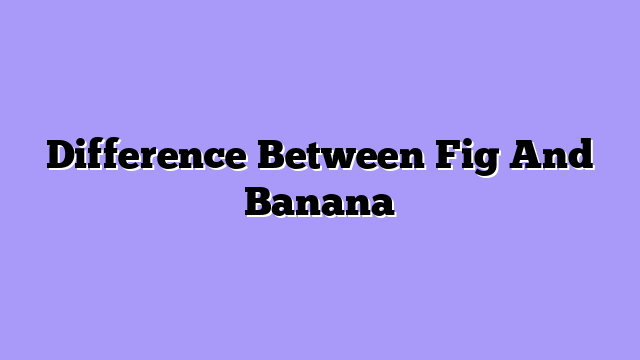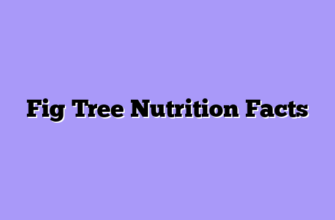Standing in my orchard on a humid morning, I often find myself marveling at the sheer diversity of the fruit world. To my left, towering Musa acuminata plants reach skyward with their massive paddle-shaped leaves creating natural umbrellas. To my right, my sprawling Ficus carica trees spread their branches wide, their distinctive lobed foliage casting dappled shadows across the ground. A visitor once asked me, “Aren’t they basically the same? Both are sweet fruits, right?” I nearly choked on my coffee.
That question, innocent as it was, revealed a common misconception that I encounter regularly. While both figs and bananas grace our fruit bowls and appear in countless recipes, they’re about as similar as a dolphin and a goldfish—sure, they both swim, but that’s where the resemblance ends. The differences between these two crops run so deep that cultivating them has taught me entirely different skill sets, challenged different aspects of my farming knowledge, and rewarded me in distinctly unique ways.
Botanical Origins: Two Completely Different Family Trees
Let’s start with the fundamentals, because understanding where these fruits come from helps explain everything else about them. Figs, scientifically known as Ficus carica and sometimes called common figs or Turkish figs depending on your locale, belong to the Moraceae family. They’re actually related to mulberries and breadfruit—a connection that surprises most people until they notice the similar milky sap these plants produce when you cut their stems.

The structural differences become obvious when you spend time working with both crops. My fig trees develop genuine woody stems and can live for decades, some specimens reportedly surviving over a century. I’ve got Brown Turkey figs on my property that were here before I arrived, their gnarled trunks testimony to their permanence. Bananas, conversely, are essentially disposable. Each pseudostem produces fruit once, then dies back. The plant survives through underground rhizomes that continuously send up new shoots. It’s like comparing a marathon runner to a relay team—different strategies for long-term success.
Key botanical distinctions:
- Figs are true trees with woody perennial growth; bananas are herbaceous perennials with temporary pseudostems
- Fig trees can reach 30 feet tall and live 50-100+ years; banana plants typically grow 10-25 feet and individual stems last 9-12 months
- Figs produce milky latex sap; bananas produce watery sap
- Fig leaves are deeply lobed and rough-textured; banana leaves are smooth, elongated, and massive
- Figs belong to Moraceae family; bananas belong to Musaceae family
- Fig roots are deep and extensive; banana roots are relatively shallow but spread widely
The Fruit Itself: What You’re Actually Eating
Here’s where things get really fascinating, and where my initial cultivation attempts taught me some humbling lessons. What we call a “fig” isn’t technically a fruit in the botanical sense—it’s an inverted flower structure called a syconium. Those tiny crunchy bits inside that people sometimes mistake for seeds? They’re actually hundreds of tiny individual fruits. The entire structure is essentially a flower turned inside-out, with the “real” fruits developing inside this fleshy container.
Mind-blowing, right? When I first learned this, I had to completely rethink my understanding of fig pollination. Some varieties, like my Calimyrna specimens (also known as Smyrna figs), require pollination by a specific tiny wasp that crawls inside through the small opening at the bottom. Other varieties, including my reliable Brown Turkey and Celeste cultivars, develop parthenocarpically—meaning they produce fruit without pollination. This self-sufficiency makes them far easier for home growers and small operations like mine.
Bananas present an entirely different situation. The fruits develop from the female flowers that emerge from the banana inflorescence, that massive purple structure locals sometimes call the banana heart or bell. The banana we eat is actually a berry—botanically speaking—that forms in large clusters called hands, with individual fruits termed fingers. Most commercial varieties, including the Cavendish plantains I grow, are seedless and develop through parthenocarpy. The tiny black specks inside? Those are aborted seeds, remnants of the banana’s wild ancestry when fruits contained large, hard seeds that made them nearly inedible.
| Characteristic | Fig (Ficus carica) | Banana (Musa spp.) |
|---|---|---|
| Botanical classification | Syconium (inverted flower) | Berry |
| What you’re eating | Fleshy receptacle containing tiny fruits | Developed ovary of flower |
| Seeds | Numerous tiny true fruits (often called seeds) | Typically seedless (wild varieties have seeds) |
| Skin | Thin, entirely edible | Thick peel, removed before eating |
| Texture when ripe | Soft, jammy, slightly grainy | Creamy, smooth, dense |
| Average size | 1-3 inches diameter | 6-9 inches length |
| Sugar content | 16-20% at peak ripeness | 12-15% when yellow-ripe |
The nutritional profiles differ substantially too. Figs pack an impressive amount of dietary fiber—about 2-3 grams per medium fruit—plus significant calcium and iron. I’ve had customers specifically seek out my fresh Mission figs (also called Franciscana) because they’re trying to increase their calcium intake naturally. Bananas, meanwhile, are potassium powerhouses, delivering roughly 450mg per medium fruit. They’re also excellent sources of vitamin B6 and provide quick-energy carbohydrates that make them favorites among the athletes who visit my farmers market stand.
Growing Requirements: Why I Need Completely Different Strategies
Walk through my farm, and you’ll notice the fig and banana sections look like different worlds. That’s because their cultivation requirements barely overlap, demanding distinct approaches to nearly every aspect of management.
Climate and hardiness needs:
Figs originated in the Mediterranean and Western Asia, and they remember their roots. Most Ficus carica varieties thrive in USDA zones 8-10, though cold-hardy types like Chicago Hardy push into zone 7. They require winter chill—a period of cold dormancy—to fruit properly. My trees go completely dormant here, dropping all their leaves and looking thoroughly dead until spring warmth triggers new growth. This dormancy is essential; varieties planted in tropical climates where temperatures never drop enough often fail to produce quality fruit.
Bananas tell a completely different story. These tropical natives prefer consistent warmth year-round, thriving in zones 9-11 for most varieties, with some cold-tolerant types surviving zone 8 with heavy protection. There’s no dormancy period. My banana plants grow continuously as long as temperatures remain above 50°F, though growth slows considerably below 60°F. Frost is catastrophic—even light freezes that my figs shrug off will kill banana leaves and damage the pseudostem. I’ve lost entire stools to unexpected cold snaps that barely fazed my fig trees twenty feet away.
Water requirements couldn’t be more different either. Figs are remarkably drought-tolerant once established. Their deep taproots—I’ve traced them down six feet during irrigation system installations—access moisture that surface roots can’t reach. I water my established fig trees maybe once a week during summer, sometimes less if we’ve had recent rain. Overwatering causes more problems than underwatering, leading to bland, watery fruits and potential root rot.
Bananas? These water-guzzlers demand consistent moisture. The massive leaves transpire enormous amounts of water—I’ve measured evaporation rates that boggle the mind. During hot summer months, mature banana plants need 1-2 inches of water weekly, sometimes more. I installed drip irrigation specifically for my banana section because hand-watering would be a full-time job. Let them dry out, and you’ll see leaf edges browning and growth stalling almost immediately.
Harvesting, Handling, and Practical Considerations
The way I harvest these two crops illustrates their fundamental differences perfectly. Fig season runs from early summer through fall depending on variety, with each tree producing fruits over an extended period. I walk my orchards every few days, checking individual fruits for ripeness indicators—the slight neck droop, the color change, that telltale softness when gently squeezed. Each Sugar fig or Brown Turkey specimen might be ready on different days, even on the same tree. It’s intimate, selective work that demands daily attention and cannot be rushed.
Banana harvesting operates on an entirely different timeline and scale. Once I see the flower begin to emerge from the center of the plant, I start counting. Depending on temperature and variety, the fruit will be ready roughly 75-90 days later. The entire hand ripens as a unit. I harvest when the individual bananas are still green but have reached full size and the angular edges have begun to round out. Unlike figs, which must ripen on the tree, bananas are harvested mature but unripe and finish ripening off the plant. This post-harvest ripening is what makes commercial banana distribution possible—something that’s virtually impossible with fresh figs.
Steps for proper banana harvest and ripening:
- Monitor the developing bunch for 10-12 weeks after flower emergence
- Check that fingers have plumped up and edges have softened from angular to rounded
- Harvest entire bunch while fruits are still green and firm
- Allow to hang in a cool, shaded area for 1-2 days for latex to drain
- Separate into smaller hands if desired
- Ripen at room temperature (60-70°F) until yellow with brown spots
- Refrigerate once ripe to extend shelf life by several days
The shelf life differences make or break commercial viability. Ripe figs last maybe five to seven days refrigerated, often less. I sell them at my farm stand within two days of harvest because beyond that, quality drops noticeably. This perishability explains why quality fresh figs command premium prices and remain somewhat exotic despite being relatively easy to grow. Bananas, ripened properly, hold for a week or more, with refrigeration extending this further. The entire global banana trade depends on this durability—figs have no such advantage.
Culinary Applications: When to Choose Which
In my farm kitchen, where I test recipes and develop value-added products, figs and bananas occupy completely different niches despite both being sweet fruits. Understanding these culinary distinctions has helped me maximize each harvest and create products my customers actually want.

Bananas offer versatility figs can’t match. Their neutral sweetness and smooth texture make them culinary chameleons. In my commercial kitchen, I process slightly overripe bananas (what we call “Gros Michel” grade, though I actually grow Cavendish) into purees for breads and smoothie packs. The high starch content when green makes plantains perfect for savory applications that would be bizarre with figs. Try making tostones with figs, and you’ll understand why botanical differences matter in the kitchen.
| Usage | Fig | Banana |
|---|---|---|
| Fresh eating | Excellent, complex flavor | Excellent, sweet and convenient |
| Baking | Good for tarts, cakes, cookies | Excellent for breads, muffins, cakes |
| Preserves | Excellent jams and preserves | Less common, mostly chutneys |
| Drying | Traditional use, intensely sweet | Chips, but texture changes significantly |
| Savory dishes | Excellent with meats, cheese | Green/plantain varieties excel here |
| Smoothies | Unusual, strong flavor | Perfect, adds creaminess |
| Shelf-stable products | Limited options beyond dried | Extensive—chips, flour, dried, freeze-dried |
The economic realities of farming both have shaped my operation significantly. Fig trees require minimal inputs once established—some pruning, occasional fertilization, pest monitoring—but produce relatively modest yields measured by weight. A mature tree might give me 50-100 pounds of fruit annually. However, those fruits command $6-10 per pound at my farm stand, making them profitable despite lower volume.
Banana plants demand more intensive management—constant water, regular fertilization, monitoring for pests and diseases, removing dead leaves and spent pseudostems—but production is substantial. A single healthy banana stool produces 40-80 pounds of fruit per cycle, and with proper management, I get continuous production year-round. The catch? Bananas wholesale for $0.50-1.50 per pound, even for specialty varieties. Profitability comes through volume and efficiency rather than premium pricing.
Why Both Have Earned Their Place
So, are figs and bananas similar? Only in the most superficial sense—both are fruits we enjoy. But as someone who works with both crops intimately, I can tell you they’re fundamentally different plants requiring different knowledge, different techniques, and offering different rewards.
Figs connect me to ancient cultivation traditions stretching back thousands of years. These trees have history, permanence, and a sense of place. When I’m pruning a mature Brown Turkey fig, I’m aware that this same tree might outlive me, providing fruit for whoever tends this land next. There’s something profound about that continuity.
Bananas represent efficiency and abundance. The rapid growth, the generous yields, the continuous production cycle—these plants embody tropical productivity. They’ve taught me about managing succession planting, optimizing nutrient delivery, and maximizing output within limited space. The lessons from banana cultivation have improved my entire farming operation.
Would I give up either crop?
Absolutely not. The diversity they represent—in botany, cultivation requirements, market position, and culinary application—makes my farm more resilient and more interesting. When fig season slows in autumn, banana production continues. When banana prices drop due to market gluts, my figs maintain premium value. When drought conditions stress most crops, my figs persist while I irrigate the bananas.
For home growers trying to choose between them, I usually ask about their climate, available space, and patience level. Got a small yard in a temperate climate? Figs might be your answer—compact, ornamental, and productive. Have subtropical conditions and room for a tropical grove? Bananas will reward you with abundance. Or, if you’re anything like me, you’ll find yourself cultivating both, marveling at their differences, and appreciating how these two remarkable fruits have almost nothing in common except that they both taste wonderful.








